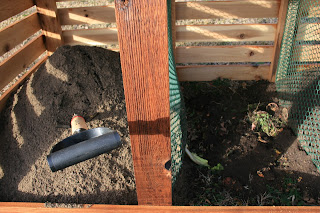Several problems have confronted me this week. First, with all the Sq Fts filled with new dirt, it has become irresistible to the two neighboring cats, Oliver and Bob, to ignore the soft digs. Google informed me of several ways to deter them, from cayenne pepper to $50 sonic zappers, also guaranteed to manage a variety of critters. While I am not a fan of outdoor kitties (mostly a nuisance that just pees, craps, digs, and gets stuck under the hood of your truck), I still don't want to harm them. And besides, if it wasn't the neighbors' cat, it would be feral cats. So, I went with a Repels All that included blood meal, garlic oil, and something else, but no cayenne. I sprinkled this all around the gardens and then took my little terrier/gremlin/thing, Maizy, out to test the potency. She marched right out to the gardens and then froze as soon as she got at whiff. Then she crouched down and sniffed everywhere like she expected to find evidence of the Squirrel Massacre. We'll see what the cats think.
Second problem. Of all the seeds, none of the pepper seeds sprouted. Everything else had a showing, even the celery, which looked liked a green hair with split-ends. I have been taking the seedlings outside for sunning each day, but two of the cucumber sprouts have been broken by the breeze. I was also surprised to see that even though the broccoli, cauliflower, and cabbage were the first to emerge, they have been the slowest to develop. Fragile, week things they seem to be next to the beans and peas. The tomatoes are no different; just tiny slips of two leaves and some timidly sprouting third leaves. But no peppers. I used seeds from past peppers and new seeds, but nothing. Google again informed me that maybe peppers prefer higher temperatures and drier conditions. So, I started again with a new tray for peppers only and let the AGA do the babysitting.
Third problem. Protecting the plants from frost. My final solution was to purchase construction grade plastic and some $1 clamps (that will rust horribly! but the plastic versions were three times the price). I planted seeds for greens, lettuces, carrots, radishes, potatoes, Swish chard, and onion sets. As I said in my last blog, I set up an example for a greenhouse type tarp. I repeated this idea for the next four gardens. We are having unseasonable warm weather for January, so during these 70 degree days, I have to open them up due to greenhouse temperatures in the 90s.
So, if the nervous neighbors haven't complained about my compost bin, this should put them over the edge. But the tarps are only temporary for the next few weeks. As you can see, I have the hose drug out from the back patio to do watering, but we are working on a better solution and I'll let you know about that when it is completed.
Composting is going as planned! I have been adding layers almost every day and there is no odour at all. There are also plenty of insects interested in my pile, which is a good thing due to their decomposing efforts.
My last thought is that I bought a book, Seed to Seed, and has been a wonderful inspiration for learning how to garden and save seeds for the next year. With our new genetic methods of farming, it is possible to create varieties that are disease and pest resistant and also with seeds that are worthless for saving. I will be purchasing my seeds next year from Seed Savers Exchange next year.
You are not the only ones interested in my exploits. I have a friendly neighbor or two that are keeping up with my activities!

























 A taste of last year's garden.
A taste of last year's garden.